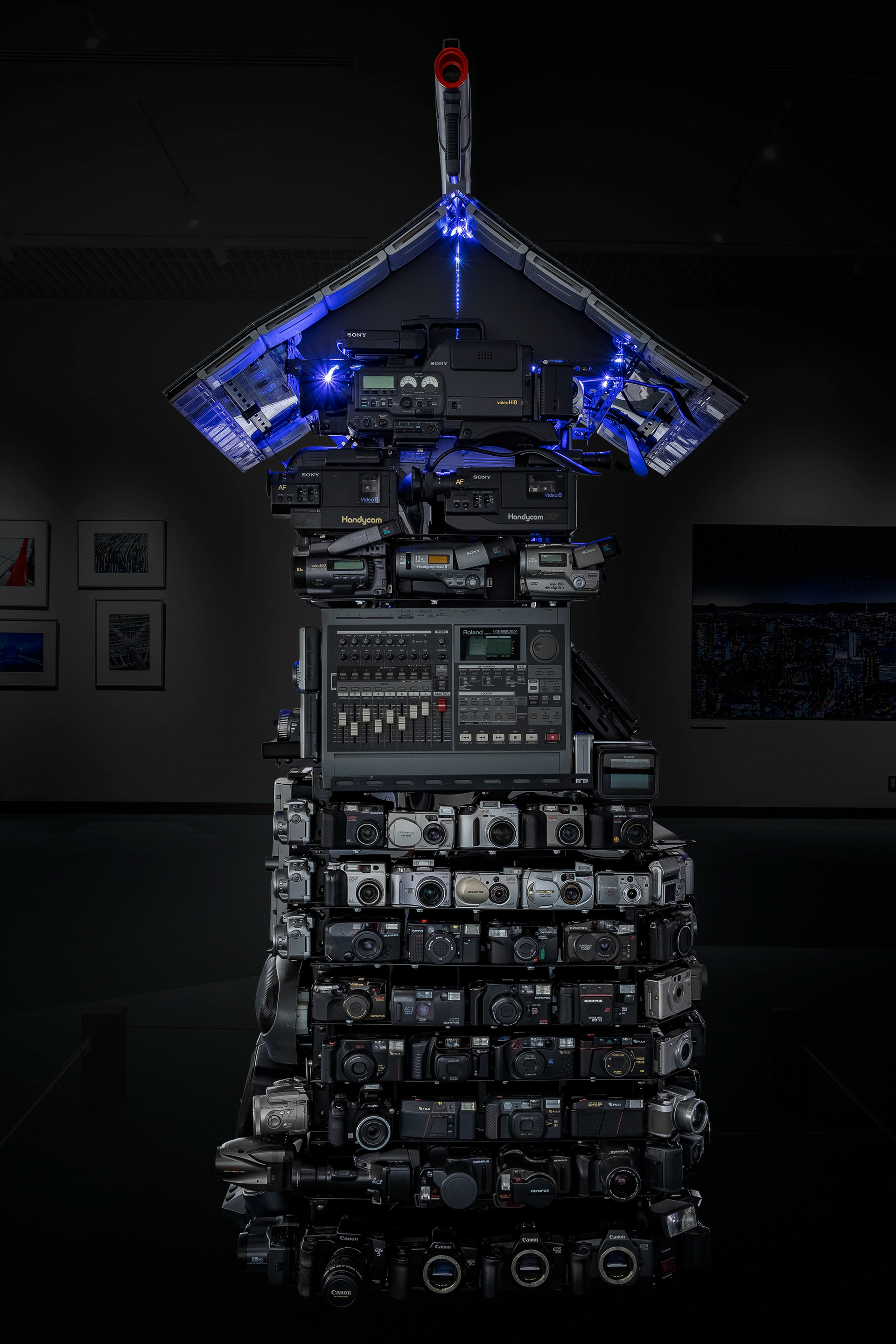
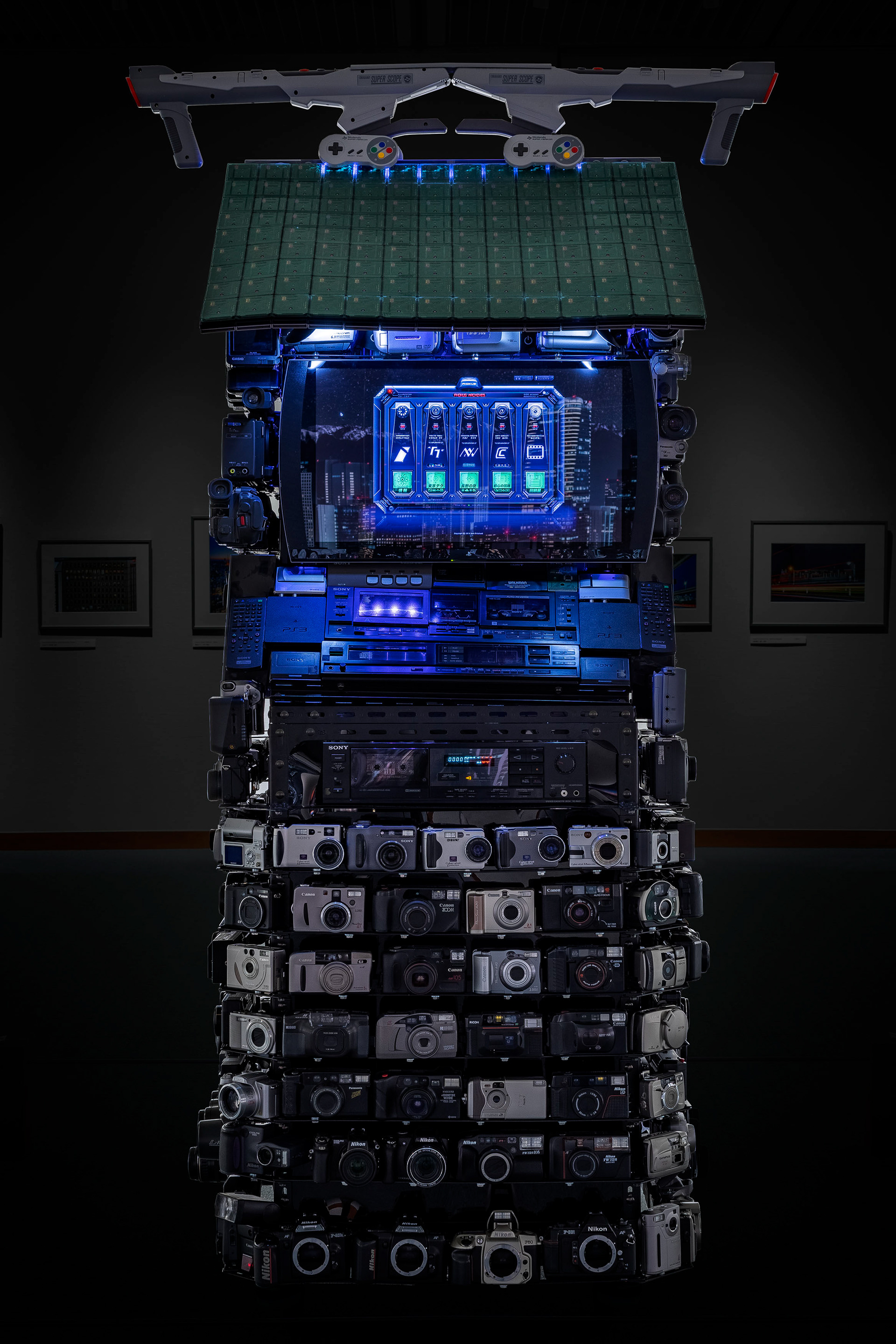

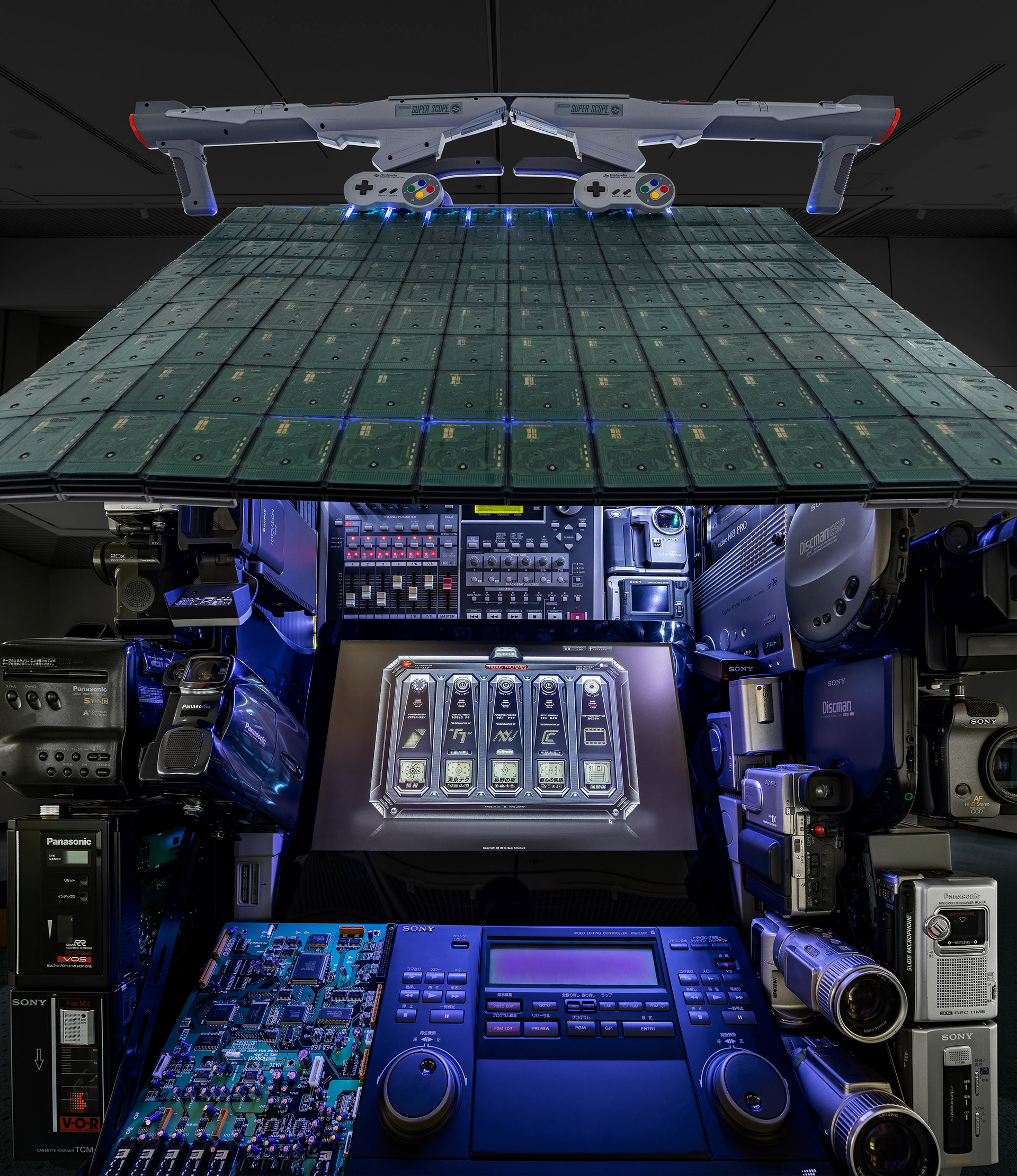

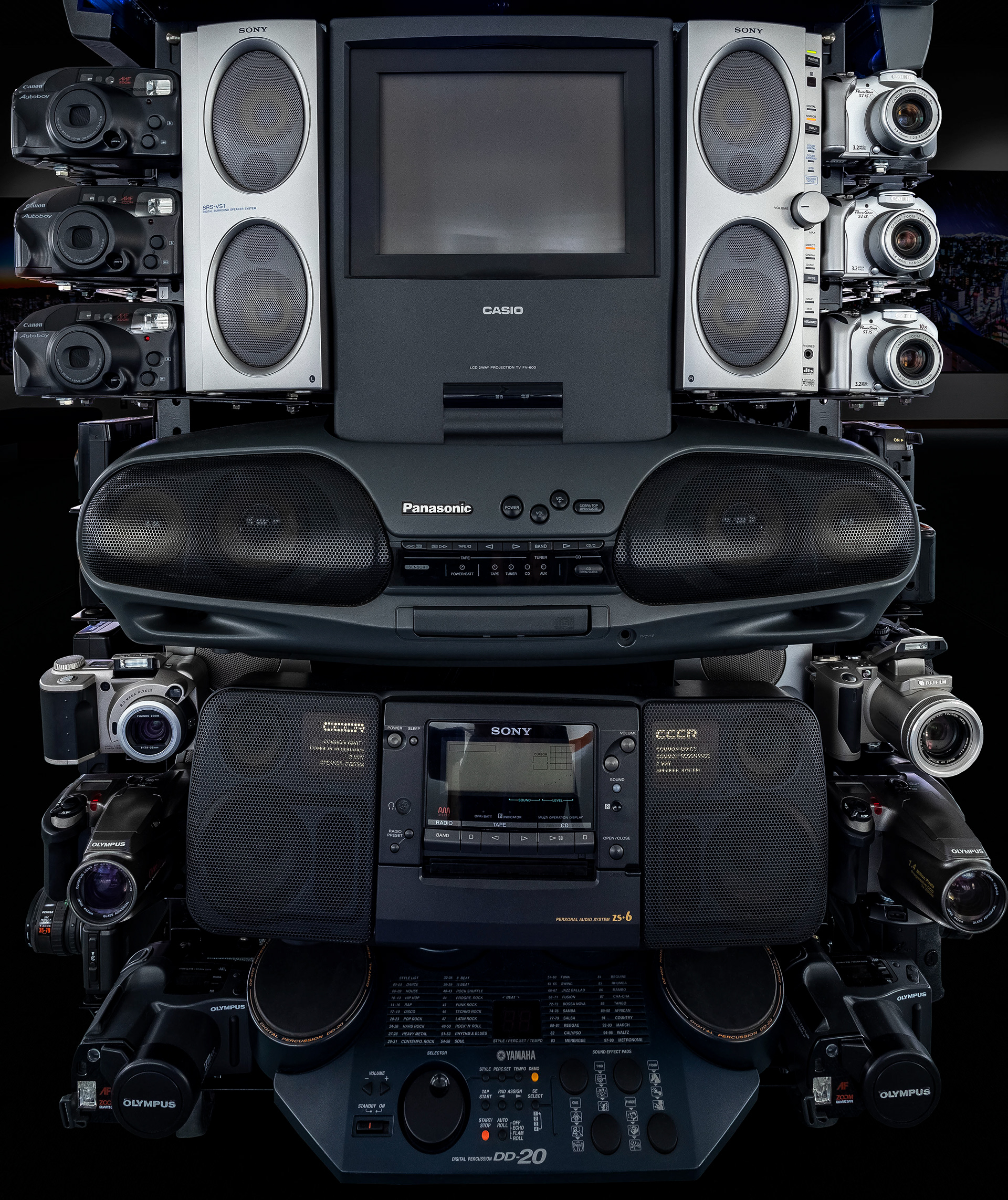
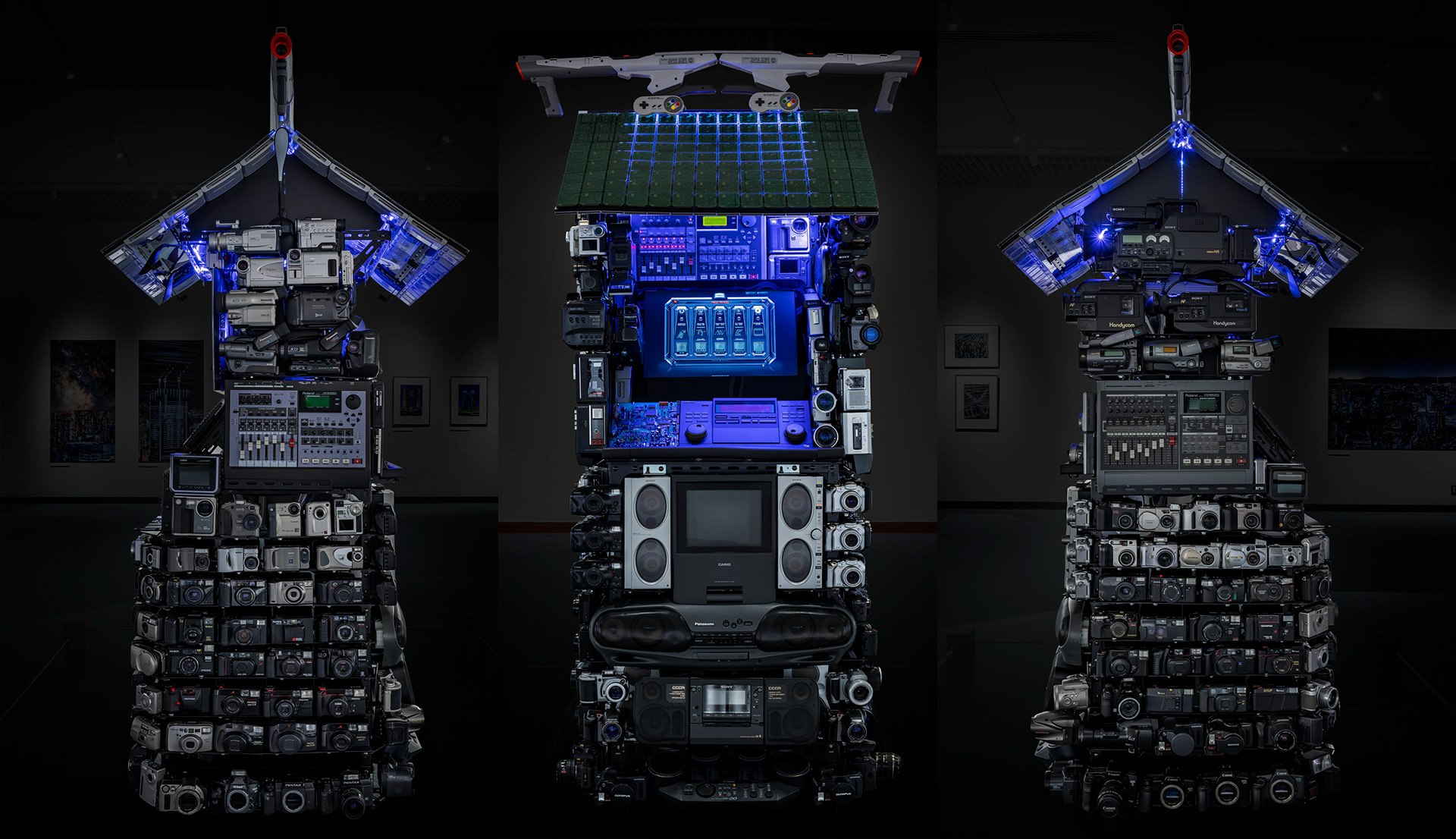
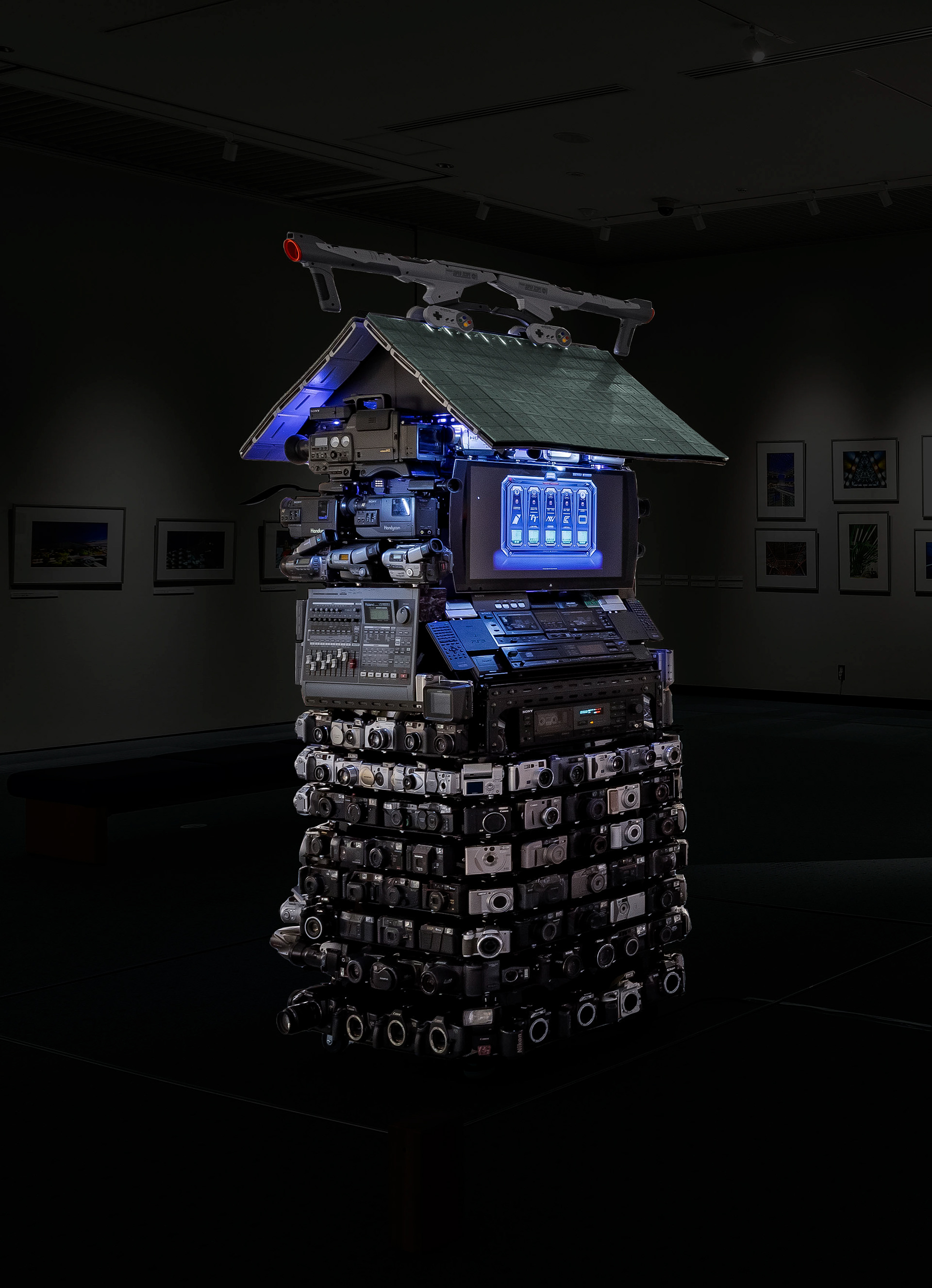
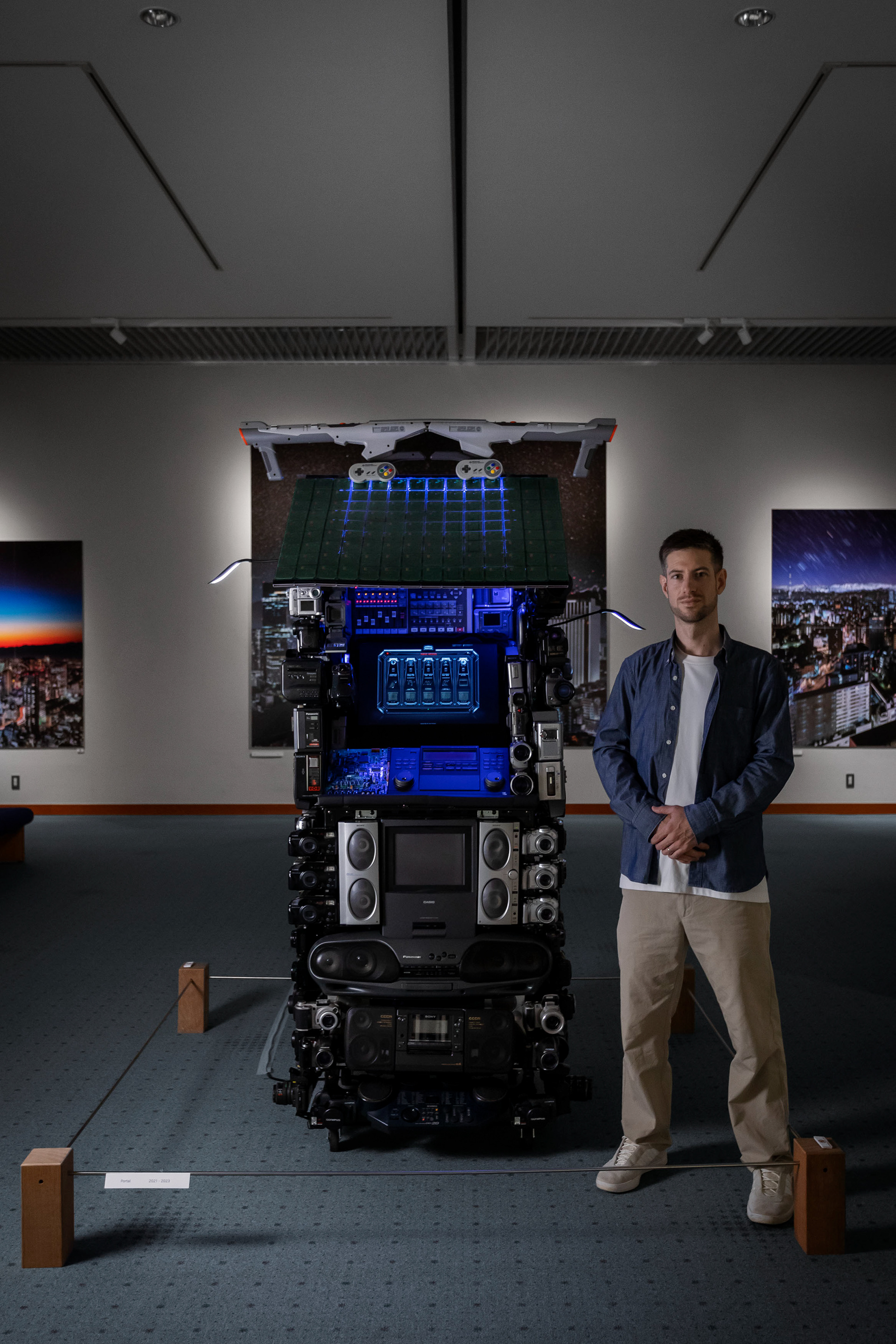

"A shrine of technology"
Sam Pritchard's latest work, Portal (2023), is both a repository and a home for The Phokus Archives (2015), an imaginary image databank created as an interactive project. Portal can be seen as an assemblage of three-dimensional objects to construct a new form, or as junk art that aims to re-recognise forgotten products. The exterior is a collection of discarded electronic devices that form the shape of a shrine. The foundation of the structure is made from a series of cameras neatly stacked like a castle stone wall, and the gabled roof is tiled with handheld video game software cartridges. The colour of the substrate of the built-in electronic circuitry realistically represents the greenish-blue colour of the copper shingles that characterise shrine architecture. The unique shape of the gun controllers that crown the structure, the result of the futuristic mechanical design aesthetic of the game console industry in the 1990s, ostentatiously completes the overall image of the object, making the work itself idolatrous and symbolic. In the centre of the main sanctuary, where a sacred mirror would normally be placed in a shrine, there is a monitor screen. This monitor is the boundary between the outside and the inside of the work, a window or portal through which the spirit contained within the work can be seen. So what is the inside of the work in relation to the external, material part of the sculpture? It is essentially the place where God exists and the centre of the environment where we can meet (feel/connect/approach) God through the shrine as a sculptural object. The Phokus Archives is the ‘God’ behind Portal, the accumulation of experience that Sam Pritchard has cultivated since childhood and the catalyst for his current artistic spirit and practice.
The Phokus Archives is a digital vault for the Land of Technology series (2015), in which the artist transformed real photographic landscapes into the futuristic Japan of his childhood dreams. In The Phokus Archives, the artist deconstructs familiar electronic devices such as cameras, camcorders, music players and game consoles and reconstructs them as image material in a hardware design format that exists only on the screen. Similarly, the details of the software user interface are resampled from the menu screens and HUD displays of video games. The operating state of the device, the light-emitting components, the screen textures and even the mechanical sounds are all individually considered and assembled. Above all, the fact that the viewer can use a mouse or controller to operate the device and navigate through the software at their own leisure encourages a natural acceptance of the work as interactive art that seamlessly connects the flow of information with the viewer's consciousness. Everyone has experienced the excitement of turning on a new electronic device for the first time, the sense of exploration and surprise at unexpected movements, and the experience of gradually becoming familiar with its operation and being able to control it as one wishes. By engaging with The Phokus Archives, you can have an experience similar to the wonder and excitement of holding a new piece of technology in your hands. In the light of all this, I now better understand why these electronic devices of yesteryear, previously displayed only as reference materials alongside The Phokus Archives, have now been transformed into figurative works of art in Portal, and why it has taken on the symbolic form of a shrine. If the existence of ‘God’ is replaced by ‘miraculous encounters beyond human comprehension’, then the same can be said of the wonders and benefits that modern technology provides us.
World-class "Made in Japan" technology is always at the forefront of its time, but it continues to evolve with a transient and aggressive attitude that can render it obsolete in an instant. In our daily lives, we are always fascinated by these technologies, attracted by their functions and cutting-edge design. However, when we actually use them, we rarely understand any of the scientific elements and mechanisms behind their operation, and can only be delighted and amazed by the results. It feels as if unknown technology is miraculous or magical, even though we know that it has been produced by other people like ourselves.
In explaining this work, I have linked the relationship between the outside (hardware) and the inside (software) to the relationship between shrines and gods in Japanese culture. Furthermore, I have applied this idea to the relationship between product design and technology as perceived by modern people. Faith, which was integrated into everyday life until the onset of modernisation, is now losing its spirit, although the concept of God remains mysterious. On the other hand, in modern society, the advances in technology that have accompanied the development of science have become universal and indispensable in people's daily lives. Until now, external and internal values have coexisted as two separate dimensions, and their integrated form has been identified as culture. Technology has been used in all of Sam Pritchard's productions to date. Although the images of the work are achieved through repeated photography with digital cameras, followed by many hours of editing and compositing in Photoshop, they exist only as virtual data stored on a computer, except at the very end of their production when they are printed as physical photographs on paper. Perhaps it was inevitable that this time the outer, physical form of Portal would be created as a vessel for the inner, virtual form of The Phokus Archives. It was also fitting that the actual devices collected in the real physical world and used as materials to construct Portal had originally influenced the inner world of The Phokus Archives. As Sam Pritchard himself says, "Portal is like a shrine made of technology". It is only when The Phokus Archives is placed inside that it becomes a symbolic work, a portal for the artist's spirit to move from the past to the future.
Shiga Kogen Roman Art Museum
Kazufumi Suzuki
最新作《Portal》(2023)は、インタラクティブプロジェクトとして開発された架空のデバイス(情報端末)《The Phokus Archives》(2015)を収めることを目的にして造られた保管庫であり、居場所でもある。立体物を寄せ集め新造形を構築するアッサンブラージュや、廃棄物の再認識を目論むジャンク・アートとしても捉えられる《Portal》の外郭(外側)の立体造形は、廃品となった電子機器の集合体が神社や祠の姿を形作る。土台は石垣のように整然と積み重なるカメラ、切妻屋根を形作るのは携帯ゲームソフトであり、内蔵される電子回路の基板の素地の色が神社建築を特徴付ける銅板葺(どうはんぶき)に浮かび上がる緑青をリアルに表している。また、屋根飾りとして据えられるのはガンシューティングゲーム用のコントローラーであり、90年代のゲーム機業界が目指した近未来的なメカデザインのセンスが生むユニークな形がオブジェとしての全体像を仰々しく完成させ、また作品そのものの存在を偶像的でシンボリックなものに仕上げている。そして本殿の中心、神社であれば本来御神体としての神鏡が祀られるのであろう場所には、モニター画面が設置されている。このモニターこそが作品の外側と内側とを繋ぐ境界面であり、作品が内包する精神を覗くことのできる窓であり、「Portal(入り口)」なのだ。では、外側の実体部分の造形に対しての“内側”とはなにか。そこは本来「神様がいる場所」であり、また造形物としての社(外側)を通じて「神様に出会える(感じる/繋がる/限りなく近づく)」ことのできる環境の中心なのではないだろうか。恐れ多くもこの概念的な存在である“神様”こそが《Portal》に“込められた”《The Phokus Archives》であり、サム・プリチャードが幼少期より培ってきた経験の蓄積と今日の表現活動を行なうようになるきっかけ、現在進行形の作家精神が常に寄り添う部分なのだろう。
《The Phokus Archives》は、現実の写真風景を作家自身が幼少期に夢見た近未来的な日本の姿へと変換させていったシリーズ《Land of Technology》(2015)のアーカイブとしての要素を持ち、同作品との融合を図ったデバイスとしての作品形態をとる。カメラ関係、音楽機材、ゲーム機など作家自身が慣れ親しんできた複数の電子機器がイメージの素材として解体され、再構築させられたデザイン的なフォーマットは画面上にのみ存在するハードウェアである。同様にソフトウェアの細部までもが従来のゲーム機のメニュー画面や操作ディスプレイのイメージを基に作り込まれ、動作状況、発光部品、画面上の質感、操作音までもがメカニカルな素材として個別に意識され組み立てられていることがわかる。何よりも鑑賞者自身がマウスやコントローラーを使用し自らの意志で操作することを可能としたことが、情報発信する作品と観賞者の意識とを繋ぐインタラクティブなアートとして自然に受け入れられるのだと感じられた。誰しもが経験する、初めて手に入れた機器を最初に起動する際の胸の躍動感、手探りで動かす探究心と予期せぬ動作による驚き、徐々に操作方法に馴れていくなかで思い通りに操る事ができるようになる体験。《The Phokus Archives》という作品と向き合うことで、人がテクノロジーを手にした時に味わう奇跡的な実感と感動とを引き寄せる体験を得ることができる。また、これまでは《The Phokus Archives》の展示に伴い資料的な参考物、イメージ材料の素として展示されてきた実物の機器の数々であるが、上記のすべてを踏まえたうえで最新作《Portal》を眺めると、なぜそれらの機器が造形作品として形を変えたのか、また“神社”というシンボリックな形態とされたのか、少し理解できた気がする。“神様”の存在を、“人知の及ばない奇跡的な物事との出会い”と置き換えるのであれば、最新のテクノロジーが与えてくれる恩恵にも同様のことが言える。
世界に誇る“メイドインジャパン”のテクノロジーは、常に時代の最先端を行くと同時に、一瞬で時代遅れの品となるという儚くも攻めた姿勢で進化し続けている。私たちも暮らしの中で常にそれらのテクノロジーに憧れを抱き、その機能や最先端のデザイン性に惹かれている。しかし、実際に使用はするものの、科学的な要素や仕組みの一切を理解することはなく、結果のみに喜びを覚え、驚愕することができるというのが現状だろう。一部の同じ人間が生み出しているはずのものであると知りつつも、未知のテクノロジーを魔法のような奇跡と感じることができるのだ。
本作品の解説をするにあたり、外側(ハード)と内側(ソフト)の関係性を、無理矢理に日本文化における神社と神様の関係性に結びつけたようなものであり、さらには現代人が感じているプロダクトデザインとテクノロジーの関係性に置き換えた。近代化が進むまでは日常に溶け込んでいた信仰は、神様の概念を神秘性として残しつつも、今やその精神は薄れつつある。対して、この現代社会において科学の発展に伴うテクノロジーの進歩は普遍的なものとなり、人々の日常には欠かせないものとなった。これまで外側の価値と内側の価値は、別次元のもの同士として共存し、一体化した姿を文化として認識させてきたといえる。サム・プリチャードのこれまでの制作には、ほぼ全てにおいてテクノロジーが駆使されてきた。デジタルカメラでの撮影、膨大な時間をかけてのフォトショップでの編集と合成の作業を繰り返すことで作品のビジュアルは完成されるものの、写真として紙に印刷されることを除けば、その存在はコンピューター上でのバーチャルなデータとして残されるのみであった。今回、《The Phokus Archives》という内側的な作品に対して、外側の造形が器として作られたのは必然だったのかもしれない。また、後から構築されたものとはいえ、現実の物理的な世界で収集され、内側に影響を与えてきた実物の機器が素材となり重なり合うことでその居場所を形作ることに意味があったといえる。「《Portal》はテクノロジーで作られた神社のようなものです。」と、サム・プリチャード自身が語る様に、《The Phokus Archives》が内側に収められたことではじめてサム・プリチャードの過去から未来へと向う作家精神の「Portal(入り口)」として、象徴的な作品となったのではないだろうか。
山ノ内町立志賀高原ロマン美術館
鈴木一史
Also be sure to check out...
